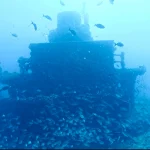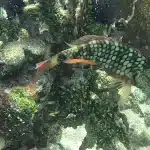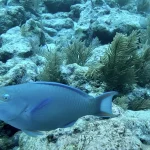Table of Contents
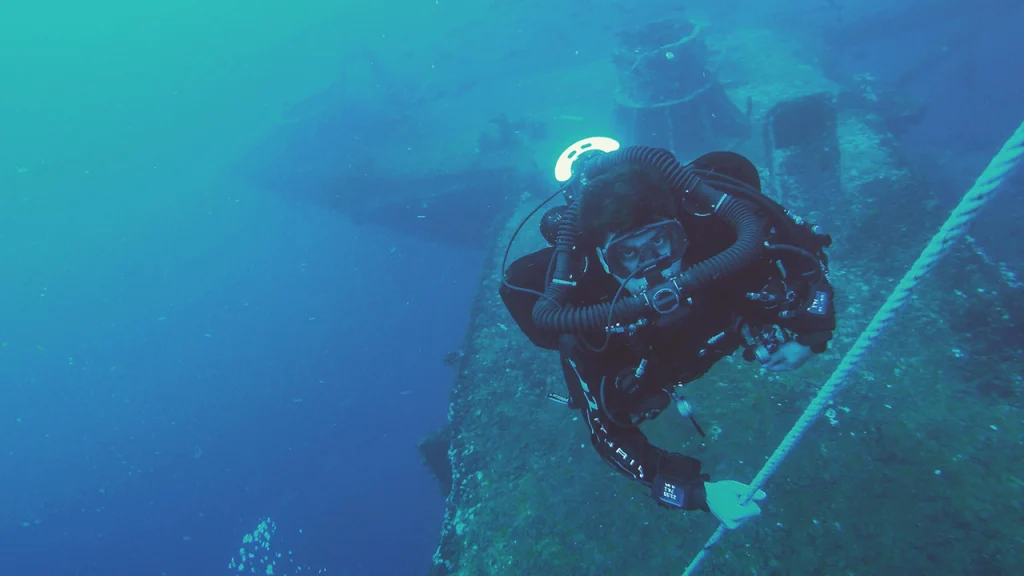
Article-at-a-Glance
- The USS Oriskany was purposefully sunk off the coast of Florida in 2006 to create an artificial reef.
- This artificial reef has become a thriving marine sanctuary and a popular dive site.
- The ship sits upright on the seafloor at a depth of 212 feet, with the top of the smokestack at 84 feet deep.
- Divers can explore vast decks and encounter a multitude of marine species that have made the Oriskany their home.
- Diving the Oriskany requires careful planning, appropriate training, and adherence to safety protocols.
The USS Oriskany: From Warship to Underwater Marvel
A Brief History of the USS Oriskany
The USS Oriskany, nicknamed the “Mighty O,” was an Essex-class aircraft carrier commissioned by the U.S. Navy in 1950. It played a significant role during the Korean War and the Vietnam War, earning multiple battle stars for its service. The Oriskany was known for its impressive capabilities, including the ability to carry up to 80 aircraft and its participation in numerous combat missions.
However, the ship’s history was not without tragedy. In 1966, a devastating fire broke out on board, claiming the lives of 44 crew members. This tragic event marked a somber chapter in the Oriskany’s storied past. Despite this, the ship continued to serve until it was decommissioned in 1976 and placed in the U.S. Navy’s reserve fleet, commonly referred to as the “mothball fleet.”
A Unique Artificial Reef
After its decommissioning, the USS Oriskany faced an uncertain future. Like many other decommissioned naval vessels, it could have ended up being scrapped or left to rust in a naval yard. However, a groundbreaking decision was made to transform the Oriskany into an artificial reef. This decision not only preserved the ship’s legacy but also created a new habitat for marine life and a unique diving attraction.
The process of turning the Oriskany into an artificial reef involved extensive planning and environmental preparations. The ship was carefully cleaned and stripped of any hazardous materials to ensure it would not harm the marine environment. This meticulous preparation was crucial to the success of the project.
Divers’ Delight: Why Dive the Oriskany?
The USS Oriskany has become a premier diving destination for several reasons:
- Historical Significance: Divers can explore a piece of naval history, making each dive a journey through time.
- Marine Life: The ship has become a sanctuary for various marine species, from colorful corals to schools of fish.
- Structure: The Oriskany’s vast decks and towering structures provide a unique and challenging diving experience.
- Depth: With depths ranging from 84 to 212 feet, the site offers opportunities for both novice and advanced divers.
- Recognition: Completing a dive on the Oriskany earns divers a “USS Oriskany Diver” recognition certificate.
Diving the Oriskany is not just about the thrill of exploration; it’s also about understanding the importance of marine conservation. By diving this artificial reef, you are witnessing firsthand the positive impact such projects can have on marine ecosystems.
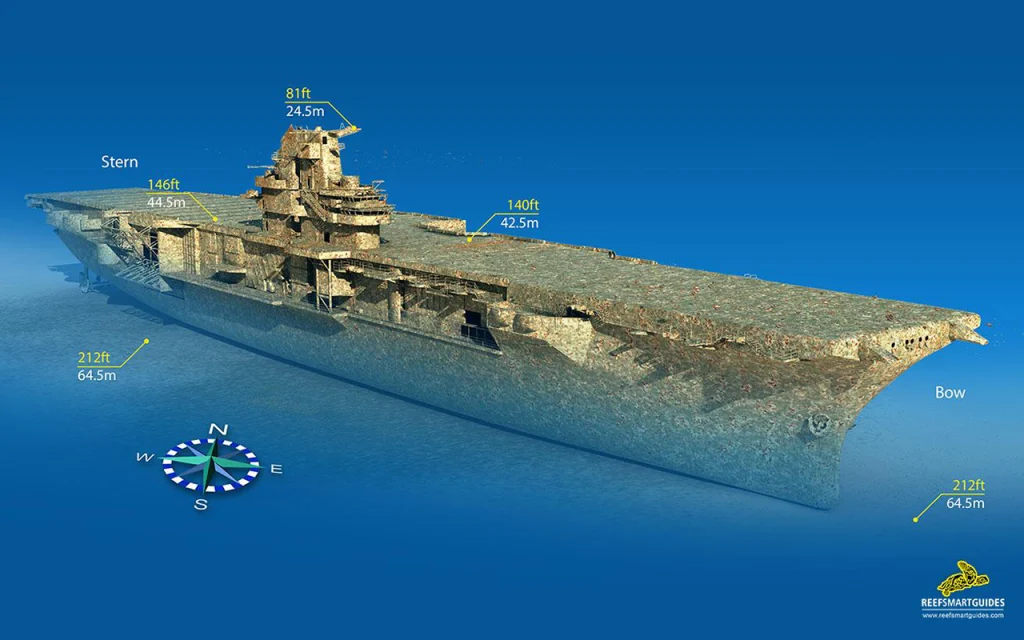
The Journey to Becoming an Artificial Reef
Decommissioning and Preservation
The decommissioning of the USS Oriskany marked the end of an era for the historic aircraft carrier. After years of service, the ship was preserved and repurposed as an artificial reef. This transformation has provided a unique diving experience for enthusiasts, who can explore the ship’s remains and observe the marine life that has made it their home. For more information, check out the USS Oriskany marine life and coral development study.
After its decommissioning in 1976, the USS Oriskany was initially placed in the reserve fleet. This period of dormancy allowed the ship to be preserved for future use, though its ultimate fate remained uncertain for many years. During this time, various proposals were considered, including scrapping the ship for metal. However, the idea of transforming the Oriskany into an artificial reef began to gain traction among marine conservationists and naval historians.
Decision to Transform
The decision to convert the USS Oriskany into an artificial reef was a pioneering move. It was driven by a desire to preserve the ship’s legacy while simultaneously creating a new habitat for marine life. This decision was not made lightly; it involved collaboration between the U.S. Navy, environmental agencies, and marine conservation organizations.
The process required careful consideration of environmental impacts, as well as extensive planning to ensure the ship would be safely and effectively transformed. The goal was to create a thriving marine sanctuary that would benefit both the environment and the diving community.
Environmental Preparations
Before the Oriskany could be sunk, it had to be thoroughly cleaned and prepared to ensure it would not pose any environmental risks. This involved removing hazardous materials such as asbestos, oil, and other contaminants. The ship was also stripped of any materials that could potentially harm marine life.
The cleaning process was meticulous, taking several months to complete. Environmental experts and engineers worked together to ensure the ship would become a safe and beneficial addition to the marine ecosystem. This preparation was crucial to the success of the artificial reef project.
“The USS Oriskany was purposefully sunk off the coast of Florida in 2006 to create an artificial reef. This artificial reef has become a thriving marine sanctuary and a popular dive site.”
The Sinking Process
Location Selection
The location for sinking the USS Oriskany was carefully chosen to maximize its benefits as an artificial reef. The site selected was approximately 22.5 nautical miles southeast of Pensacola Pass, Florida. This location offered the ideal depth and environmental conditions for the ship to become a successful artificial reef.
Besides that, the chosen site was easily accessible to divers, making it a prime location for dive tourism. The proximity to Pensacola also provided logistical advantages for monitoring and maintaining the artificial reef.
Sinking Day: A Controlled Descent
On May 17, 2006, the USS Oriskany was carefully sunk in a controlled descent. This process involved strategically placed explosives that ensured the ship would sink upright and settle on the seafloor in the desired orientation. The controlled sinking was a critical aspect of the project, as it determined how the ship would interact with the marine environment.
The sinking was a significant event, drawing attention from marine conservationists, divers, and the general public. The successful descent of the Oriskany marked the beginning of its new life as an artificial reef and diving attraction.
Monitoring and Immediate Impact
Following the sinking, the USS Oriskany was closely monitored to assess its impact on the marine environment. Scientists and environmental experts conducted studies to observe how marine life began to colonize the ship and how the artificial reef was developing.
The initial impact was promising, with marine species quickly taking up residence on the Oriskany. Corals, sponges, and various fish species started to inhabit the ship, transforming it into a vibrant underwater ecosystem. This immediate colonization was a positive sign that the artificial reef project was on the right track.
Exploring the Oriskany as a Diving Site
Conditions and Accessibility
Diving the USS Oriskany is an adventure that requires some planning and preparation. The ship rests at a depth of 212 feet, making it accessible to both recreational and technical divers. The top of the smokestack is at a more manageable depth of 84 feet, which is suitable for less experienced divers. However, due to the depth and potential hazards, it’s recommended that divers have at least an advanced open water certification and experience with deep dives.
Weather conditions and currents can vary, so it’s essential to check local forecasts and dive reports before planning your trip. The best time to dive the Oriskany is typically from April to October when the water is warmer and visibility is better. It’s also advisable to book a dive charter that specializes in trips to the Oriskany to ensure a safe and enjoyable experience.
Key Dive Spots on the Oriskany
The USS Oriskany offers several exciting dive spots, each with its unique features:
- The Island: The ship’s superstructure, known as the “island,” is a popular spot for divers. It includes the bridge, radar platforms, and the admiral’s quarters. The island is relatively shallow, with depths ranging from 84 to 130 feet.
- Flight Deck: The expansive flight deck sits at about 145 feet and is a fascinating area to explore. Divers can see where aircraft once launched and landed, and the deck is now home to various marine species.
- Hangar Bay: For more experienced divers, the hangar bay offers an opportunity to explore the ship’s interior. This area is deeper, around 175 feet, and requires careful navigation due to its enclosed spaces.
- Propellers: The ship’s massive propellers are located at the stern and rest at the deepest part of the wreck, around 212 feet. This spot is ideal for technical divers looking for a challenging dive.
Diving Safety Tips
Before diving, it’s crucial to familiarize yourself with the location and conditions of the dive site. For example, the USS Oriskany offers a unique diving experience but requires specific preparation due to its depth and marine life.
Diving the USS Oriskany can be an exhilarating experience, but it’s essential to prioritize safety. Here are some key tips to ensure a safe dive:
- Plan Your Dive: Always plan your dive and dive your plan. Ensure you have a clear understanding of the dive site, depths, and potential hazards.
- Use Proper Equipment: Ensure your diving equipment is in good working order and suitable for deep dives. This includes a reliable dive computer, redundant air supply, and appropriate exposure protection.
- Buddy System: Never dive alone. Always dive with a buddy and maintain communication throughout the dive.
- Monitor Air Supply: Keep a close eye on your air supply and plan your dive to ensure you have enough air for a safe ascent.
- Ascend Slowly: Follow proper ascent rates and make safety stops to prevent decompression sickness.
- Be Aware of Currents: Currents can be strong around the Oriskany. Plan your dive accordingly and be prepared to adjust your dive plan if necessary.
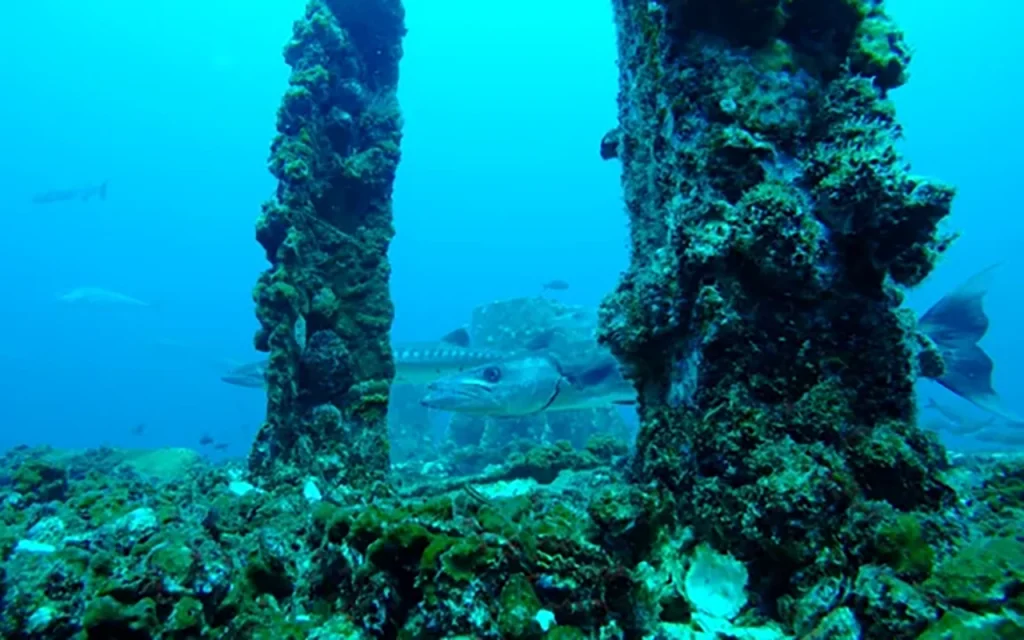
Impact on Marine Life
The transformation of the USS Oriskany into an artificial reef has had a significant impact on marine life. The ship now serves as a thriving habitat for various species of fish and coral, promoting biodiversity in the area. Divers and researchers have noted the rapid colonization of marine organisms, which has been documented in studies such as the USS Oriskany marine life and coral development study.
Initial Marine Colonization
After the Oriskany was sunk, marine life began to colonize the ship almost immediately. Within weeks, algae and small invertebrates started to cover the surfaces, providing a foundation for other species to thrive. Fish and other marine creatures were attracted to the new structure, finding shelter and food in the nooks and crannies of the ship.
The rapid colonization was a positive sign, indicating that the artificial reef was functioning as intended. This initial phase set the stage for more complex marine communities to develop over time.
Growth Over Time
As the years passed, the USS Oriskany continued to attract a diverse array of marine species. Corals, sponges, and other sessile organisms established themselves on the ship’s surfaces, creating a vibrant and colorful underwater landscape. These organisms provided habitat and food for various fish species, which in turn attracted larger predators.
The ship’s structure, with its multiple levels and enclosed spaces, offered ideal conditions for different species to coexist. This complexity allowed for a dynamic and thriving ecosystem to develop, benefiting both the marine environment and divers who come to explore it.
“The USS Oriskany sits upright on the bottom in 220ft of water. The top of the smokestack is 84ft deep. Most of the Island including the admiral’s and navigation bridges are accessible to divers.”
Current Marine Residents
Today, the USS Oriskany is home to a wide variety of marine life. Divers can encounter species such as:
- Grouper: Large grouper fish are often seen patrolling the ship’s decks and structures.
- Snapper: Schools of snapper are commonly found around the ship, adding to the vibrant underwater scene.
- Barracuda: These sleek predators are frequently spotted near the wreck, taking advantage of the abundant prey.
- Sea Turtles: Occasionally, sea turtles can be seen exploring the ship, adding a touch of grace to the underwater environment.
- Corals and Sponges: Various coral species and sponges have colonized the ship, creating a colorful and diverse habitat.
The presence of these species highlights the success of the artificial reef project and the positive impact it has had on the marine ecosystem.
Tourism and Economic Benefits
The transformation of the USS Oriskany into an artificial reef has significantly boosted local tourism. Divers from around the world visit to explore the wreck, contributing to the local economy. This initiative not only preserves marine life but also promotes sustainable tourism. For more information on similar projects, check out the USS Oriskany marine life and coral development study.
The transformation of the USS Oriskany into an artificial reef has not only benefited marine life but has also had significant economic impacts. The site has become a popular destination for divers, contributing to local tourism and the economy.
Dive Tourism Boom
The USS Oriskany has attracted divers from around the world, eager to explore the historic ship and its vibrant marine life. Dive charters and tour operators have capitalized on this interest, offering specialized trips to the Oriskany. This influx of dive tourism has created new business opportunities and boosted the local economy.
Besides that, the Oriskany has also gained recognition in the diving community, further enhancing its appeal as a must-visit dive site. The combination of historical significance and rich marine life makes it a unique and compelling destination for divers of all levels. For more information, check out this USS Oriskany dive guide.
Impact on Local Economy
The transformation of the USS Oriskany into an artificial reef has had a significant impact on the local economy. The site has become a popular destination for divers, boosting tourism and creating new business opportunities in the area. For more information about the USS Oriskany, visit MBT Divers.
The economic benefits of the Oriskany artificial reef extend beyond dive tourism. Local businesses, including hotels, restaurants, and shops, have seen increased patronage from visiting divers. The project has also created jobs in the dive industry, from charter operators to dive instructors and guides.
Furthermore, the success of the Oriskany has inspired similar projects, demonstrating the potential for artificial reefs to contribute to both marine conservation and economic development. The positive impact on the local economy underscores the value of innovative conservation efforts like the Oriskany artificial reef.
Conclusion: A Legacy Under the Waves
The transformation of the USS Oriskany from a formidable warship to a thriving artificial reef is a testament to the power of innovative conservation efforts. This project has not only preserved a piece of naval history but also created a new habitat for marine life and a unique diving attraction that continues to inspire and educate.
The Oriskany’s Dual Legacy
The USS Oriskany, once a proud warship, now serves as a vibrant artificial reef. This transformation has made it a popular destination for divers.
The USS Oriskany’s legacy is twofold. On one hand, it stands as a memorial to the thousands of men who served on board during its years of active duty. On the other hand, it has become a symbol of marine conservation and the positive impact that artificial reefs can have on the environment. This dual legacy ensures that the Oriskany will be remembered and appreciated by future generations.
Continued Importance
The continued importance of the USS Oriskany lies in its ability to educate and inspire. Divers who explore the ship gain a deeper understanding of marine ecosystems and the role that artificial reefs play in supporting biodiversity. Moreover, the success of the Oriskany project serves as a model for future conservation efforts, demonstrating the potential for creative solutions to address environmental challenges.
Frequently Asked Questions (FAQ)
How deep is the USS Oriskany?
The USS Oriskany, a former aircraft carrier, was intentionally sunk to become an artificial reef. This transformation has made it a popular diving attraction. For more information about the Oriskany Reef, including its depth and diving conditions, visit the Florida Fish and Wildlife Conservation Commission website.
The USS Oriskany sits upright on the seafloor at a depth of 212 feet. The top of the smokestack is at 84 feet deep, making it accessible to both recreational and technical divers, similar to the USS Duane shipwreck.
What marine life can I expect to see on a dive?
Divers can encounter a variety of marine life on the Oriskany, including grouper, snapper, barracuda, and sea turtles. The ship is also home to various coral species and sponges, creating a vibrant underwater habitat.
What is the best time of year to dive the Oriskany?
The best time to dive the Oriskany is during the summer months when the water conditions are most favorable.
The best time to dive the Oriskany is typically from April to October. During these months, the water is warmer, and visibility is generally better, providing optimal conditions for diving.
Is the Oriskany suitable for novice divers?
The USS Oriskany is a popular diving site that attracts both experienced and novice divers. However, due to its depth and size, it is recommended that only advanced divers attempt to explore the wreck.
While parts of the Oriskany are accessible to less experienced divers, such as the smokestack at 84 feet, it is recommended that divers have at least an advanced open water certification and experience with deep dives due to the site’s depth and potential hazards.
Are there any special permits required to dive the Oriskany?
No special permits are required to dive the Oriskany. However, divers must adhere to local regulations and guidelines, and it is advisable to book a dive charter that specializes in trips to the Oriskany to ensure a safe and enjoyable experience.
The USS Oriskany’s transformation into an artificial reef is a remarkable example of how human ingenuity can benefit the environment. By diving this historic ship, you are not only exploring a fascinating underwater world but also supporting marine conservation efforts. So, gear up, dive in, and become part of the Oriskany’s enduring legacy.
North Florida Wrecks
- USS Oriskany
- USS Massachusetts
- SS Tarpon
- SS Gulf America
- Empire Mica
- USS Chippewa
- Avocet
- Black Bart
- The Vamar
- San Pablo
- USS Narcissus
- The Loftus Wreck
- The Dorothy Louise
- The Mizpah
- MV Janet
- The Eidsvag
- YDT-14 and YDT-15
- USS Strength
- Miss Louise
- The Lulu
- PC-1174
- Three Coal Barges
- USS Accokeek (ATA-181)
- El Dorado
- The Grey Ghost
- The Pete Tide II
- Red Sea Tug

